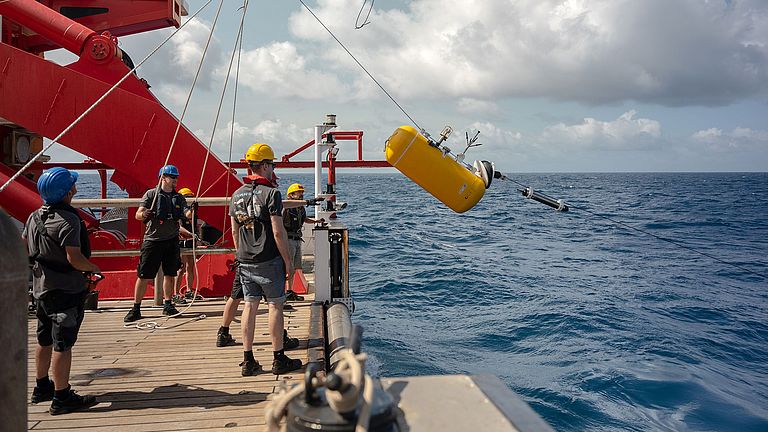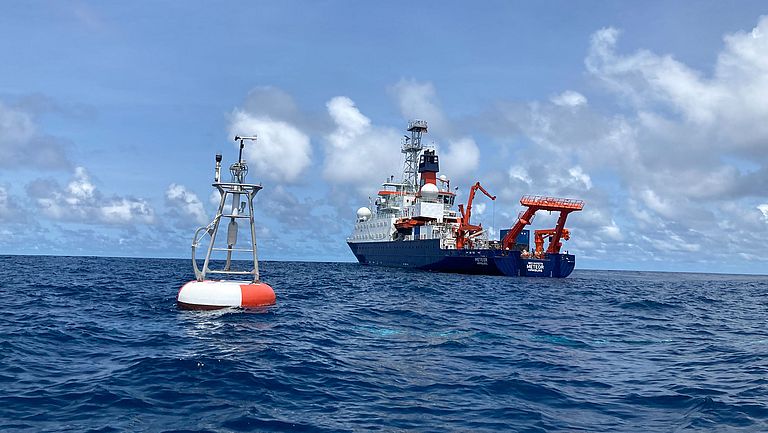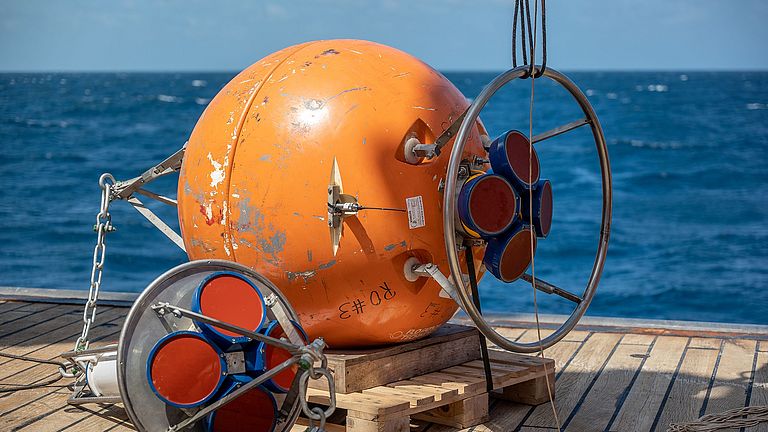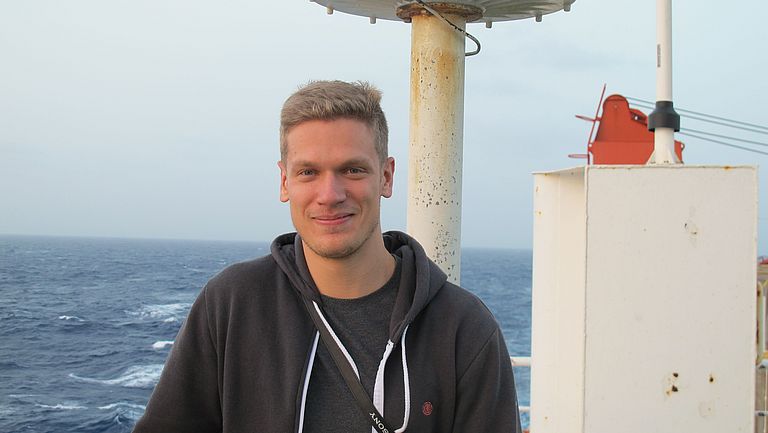Twenty years of ocean current observations for an improved understanding of climate variability
Data from one of the longest time series in the tropical Atlantic now publicly available
From the regional oxygen supply to impacting weather conditions: Ocean currents are important for life in the ocean as well as for the climate over the surrounding continents. For these reasons, an ocean observatory at the equator, at 23°W, has been recording the velocities of the equatorial current system for the last 20 years down to 3500 m water depth. Scientists at GEOMAR Helmholtz Centre for Ocean Research Kiel, in collaboration with French and US project partners, have now made this long-term series publicly available as a consistent data set for the first time. The description of the individual instruments and further details about the measurements and the building of the time series have been published today in the journal Frontiers in Marine Science.
“We are only able to detect long-term trends and variability of the ocean currents on climate relevant time scales of years to decades with the help of continuous long-term observations” states Dr. Franz Philip Tuchen. The physical oceanographer began his work with the current data as a student research assistant at GEOMAR in 2014. As a doctoral researcher at GEOMAR he continued to prepare and analyze the data during several research cruises. In early 2022 he started a position as a Postdoctoral Research Associate at the National Oceanic and Atmospheric Administration (NOAA) Atlantic Oceanographic and Meteorological Laboratory in Miami, USA where he will continue to manage the time series. He is the first author of the publication.
„Huge financial and logistic challenges are involved in maintaining such a time series over a long period of time. This is especially true for remote regions in the open ocean, which are also crucial components of our climate system.“ says Dr. Tuchen. “It is important to share this time series with the scientific community. The publication of the data of all instruments from no less than 13 anchoring periods in a uniform and freely accessible data set was therefore a long overdue step.” Until now, only individual components of the time series, that is considered one of the longest and most established time series of its kind in the tropical oceans, have been made accessible. Subsets and individual parts of the time series have already been used in more than 30 scientific publications and master and doctoral theses. “This marks only the start. With the publication of the time series and its consistent analysis, we want to further improve our understanding of equatorial ocean dynamics and tropical climate variability.”
Over the years, the data helped to identify features of the deep equatorial circulation, such as equatorial deep jets, and their impact on climate variability. More recently, the length of the time series allowed to analyze decadal changes of the near-surface circulation and its connection to changes in regional oxygen concentration. The researchers hope that the time series will be further used to validate ocean and climate models. “Continuous observations facilitate detailed insights into crucial components of the ocean and climate system which determine our life on this planet in manifold ways” emphasizes Dr. Peter Brandt, Professor for Physical Oceanography at GEOMAR and co-author of the study. “The analysis of the data is carried out in collaboration with several marine science disciplines such as physical, biogeochemical and biological oceanography. In order to provide a good representation of the observed currents in ocean and climate models, theoretical and observational oceanographers as well as modelers work closely together. This way, ocean models and climate predictions can be improved to make informed statements about climate variability and climate change and their role for human kind.”
The observatory consists of two so-called moorings. In general, a mooring can be seen as a steel wire that is fixed at the ocean bottom with an anchor and kept upright in the water column by glass spheres providing buoyancy. This way, a variety of different instruments can be attached to the wire to measure, for instance, temperature, salinity, oxygen, current velocity and many more parameters. Approximately every 1 to 2 years, the mooring and the gained data are recovered with the help of research vessels and a new mooring is deployed. The observatory at 23°W combines a variety of different instruments to measure ocean currents, which differ especially in their sampling frequency and in the covered vertical range. The next research cruise to the equatorial 23°W mooring and therefore the next update of the time series is scheduled for spring 2023 aboard the German research vessel RV MARIA S MERIAN (MSM cruise 117), led by chief scientist Dr. Rebecca Hummels.
Background: Involved projects
The observatory at the equator is an integral component of the tropical Atlantic observing system (TAOS) and is maintained in close cooperation with the Prediction and Research Moored Array in the Tropical Atlantic (PIRATA). The different phases of the long-term mooring have been embedded in several national and international programs:
- The Tropical Atlantic Climate Experiment (TACE) in the frame work of the Climate Variability and Predictability program (CLIVAR) of the World Climate Research Programme (WCRP)
- The Collaborative Research Centre 754 (Sonderforschungsbereich 754) “Climate – Biogeochemistry Interactions in the Tropical Ocean” sponsored by the German Research Foundation (Deutsche Forschungsgemeinschaft, DFG)
- The program “Regional Atlantic Circulation and Global Change” (RACE) sponsored by the Federal Ministry of Education and Research Germany (Bundesministerium für Bildung und Forschung, BMBF)
- The European Union project “Tropical and South Atlantic climate-based marine ecosystem prediction for sustainable management” (TRIATLAS)
Publication:
Tuchen, F. P., Brandt, P, Hahn., J, Hummels., R., Krahmann, G., Bourlès, B., Provost, C., McPhaden, M. J., Toole, J. M., (2022): Two decades of full-depth current velocity observations from a moored observatory in the central equatorial Atlantic at 0°N, 23°W, Frontiers in Marine Sciences,
doi: https://doi.org/10.3389/fmars.2022.910979






